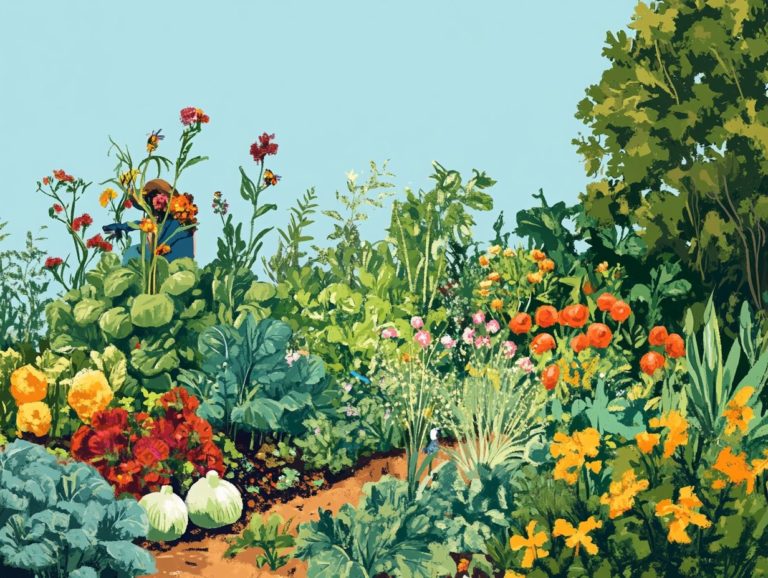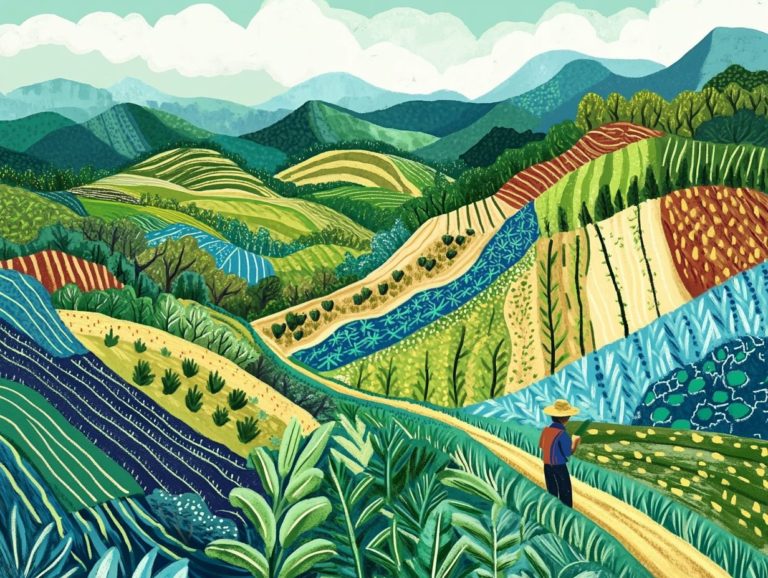How to Plan for Seasonal Changes in Permaculture?
Seasonal changes are crucial to the success of your permaculture endeavors. They affect everything from soil health to the yields you can expect from your crops.
By learning how to work with nature’s seasons, you can significantly boost both productivity and sustainability.
This article delves into the fundamentals of whole systems design in permaculture, examining the influence of seasonal shifts while providing you with practical strategies for creating a seasonal calendar, adjusting your planting schedules, and maximizing your yields.
It also covers how to adapt to unexpected weather events, ensuring that your permaculture system remains resilient throughout the year, particularly in the face of climate change.
Explore how you can harmonize your gardening practices with the seasons, incorporating sustainable practices that benefit both your crops and the environment!
Contents
- Key Takeaways:
- Understanding Seasonal Changes in Permaculture
- Planning for Seasonal Changes
- Maximizing Productivity in Each Season
- Adapting to Unexpected Changes
- Frequently Asked Questions
- Why Do I Need to Plan for Seasonal Changes in Permaculture?
- How Do I Start Planning for Seasonal Changes in Permaculture?
- What Are Some Common Methods for Planning Seasonal Changes?
- How Can Permaculture Design Principles Help?
- What Challenges Should I Consider?
Key Takeaways:
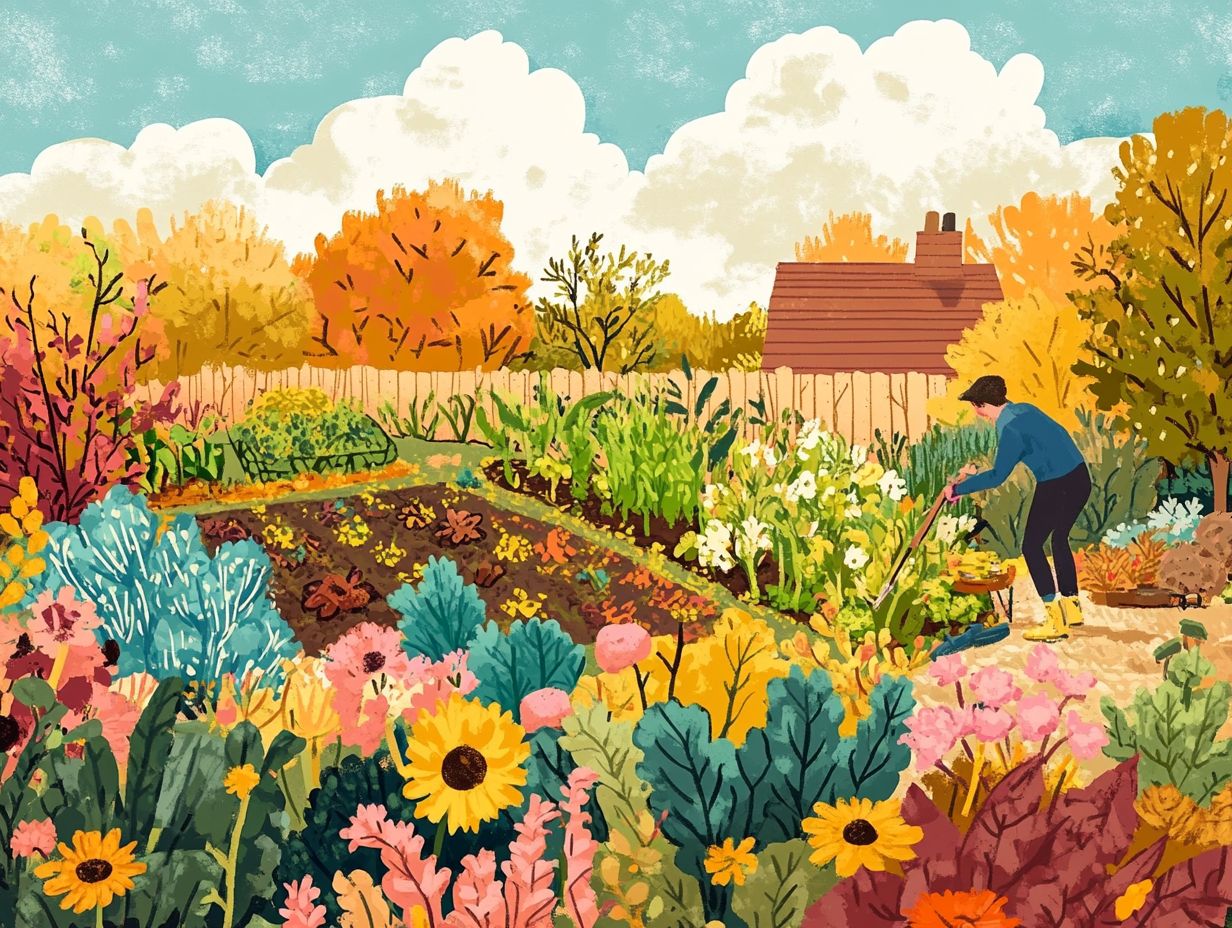
- Learn how seasonal changes shape your permaculture practices, maximizing productivity through effective farming methods.
- Create a seasonal calendar and adjust planting and harvesting schedules to optimize yields throughout the year, considering factors such as water management and historical land use.
- Have strategies in place for different weather conditions and be prepared to adapt plans for unexpected circumstances, leveraging the principles of regenerative agriculture to ensure the success of your permaculture system.
Understanding Seasonal Changes in Permaculture
Understanding seasonal changes in permaculture is essential for effective land use and holistic systems design. These factors greatly influence soil health, biodiversity, and overall agricultural productivity.
Permaculture embraces the principles of regenerative agriculture, aiming to create sustainable ecosystems resilient to climate change.
By thoughtfully assessing seasonal shifts, you can adapt your strategies to maintain ecological balance and enhance food production while fostering community collaboration.
This holistic approach empowers you and fellow land stewards to work in harmony with nature, ensuring the longevity and vitality of the landscapes you cultivate.
What is Permaculture?
Permaculture serves as a design methodology that champions sustainable agricultural practices by emulating the natural ecosystems found in diverse ecological landscapes.
This innovative approach invites you to cultivate diverse and resilient agricultural systems by emphasizing the intricate relationships among plants, animals, and the environment.
By adopting principles like keen observation, efficient resource utilization, and the creation of symbiotic relationships, you can design landscapes that actively enhance soil health.
Methods such as cover crops, composting, and crop rotation are seamlessly integrated into this system, elevating soil fertility and structure.
Furthermore, permaculture thrives on biodiversity by incorporating a rich variety of flora and fauna, leading to stable ecosystems capable of withstanding pests and diseases.
This holistic approach lays the groundwork for a sustainable and flourishing agricultural future.
How Seasons Affect Permaculture
Seasons play a crucial role in permaculture, directly influencing soil health, biodiversity, and the overall effectiveness of your crop rotation strategies.
By grasping the unique characteristics of each season, you can tailor your planting and harvesting cycles to optimize your yields.
For instance, spring and summer present perfect conditions for planting a variety of annual crops, while autumn provides the ideal window for harvesting and preparing the soil for winter cover crops.
Choosing perennial plants can significantly enhance biodiversity and enrich your ecosystem, creating habitats for beneficial insects.
However, it is essential to acknowledge that climate change is disrupting these seasonal patterns, leading to fluctuations in weather that challenge traditional practices.
This necessitates adaptations in your soil management and crop selection to ensure sustainability and resilience, particularly in light of nutrient pollution issues.
Planning for Seasonal Changes
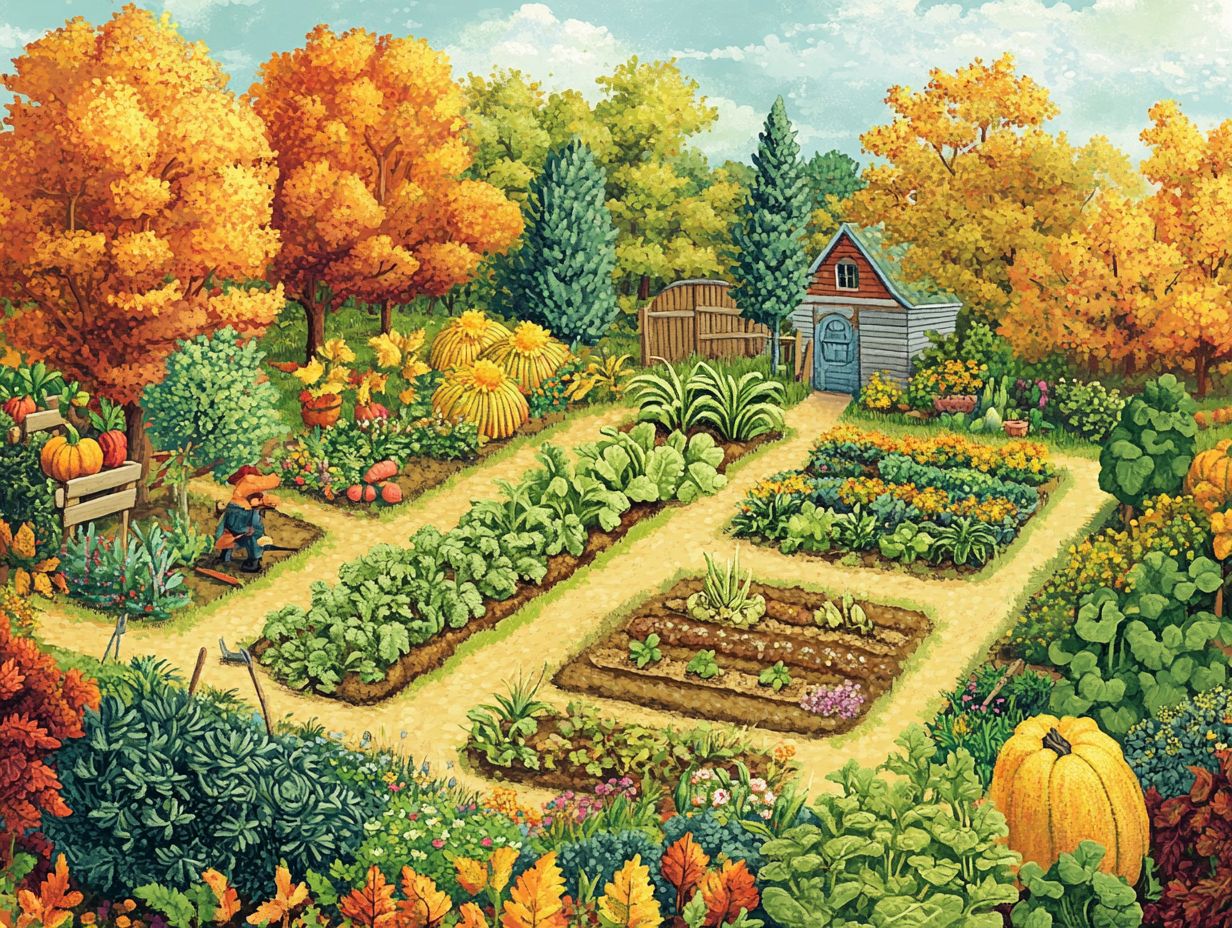
Planning for seasonal changes is essential in permaculture. It helps ensure your land use strategies align with the natural cycles of the environment.
This alignment optimizes resource management and promotes sustainable practices.
A well-structured seasonal calendar will serve as your roadmap. It helps you navigate these transitions and adapt your farming methods accordingly.
By considering factors like water management, soil health, and crop rotations, you can cultivate resilient agricultural systems that flourish throughout the year.
This powerful approach supports biodiversity and bolsters your community s ability to respond effectively to climate fluctuations, much like the inspiring initiatives at Ocean Hour Farm.
Creating a Seasonal Calendar
Creating a seasonal calendar in permaculture requires you to grasp the optimal planting and harvesting schedules. These should be tailored to your local climate conditions and historical land use practices.
Start by gathering and analyzing local climate data, including temperatures, rainfall patterns, and frost dates.
By carefully assessing these factors, you can make informed decisions about the best times to plant various crops. This ensures they thrive throughout the growing season.
Insights from historical land use practices provide valuable context. They reveal which species have flourished in your area over time, allowing for a more customized approach.
Engaging with local farmers and community gardeners is essential. They can share wisdom derived from their own experiences.
This synergy between understanding climate, recognizing historical patterns, and incorporating community input cultivates a sustainable approach to agriculture, particularly within permaculture systems. It promotes food security.
Adjusting Planting and Harvesting Schedules
Adjusting your planting and harvesting schedules is crucial in permaculture. This flexibility allows you to respond effectively to seasonal changes and the impacts of climate change.
By adopting this adaptive approach, you can significantly enhance biodiversity and resilience within your ecosystems.
Experimenting with crop rotation and growing different crops together will foster synergistic relationships among your plants. For instance, incorporating nitrogen-fixing species will replenish soil nutrients, resulting in healthier yields.
Using local climate data empowers you to make smart planting choices!
Ultimately, by integrating these dynamic strategies, you not only shield your practices against extreme weather events but also cultivate a thriving agricultural environment that promotes sustainability and food security.
Maximizing Productivity in Each Season
Maximizing productivity in each season is essential in permaculture. It requires effective strategies that align with seasonal crops and the unique characteristics of ecological landscapes.
By gaining a deep understanding of what each season offers, you can optimize your land use, enhance soil health, and cultivate a diverse array of produce.
This thoughtful approach supports sustainable practices and builds resilience against the challenges of climate change.
You might consider integrating methods such as crop rotation, companion planting, and heritage livestock. All of these contribute to a thriving and harmonious ecosystem.
Don t miss out on the benefits of maximizing your seasonal productivity act now!
Strategies for Different Seasons

Tailored strategies for each season are crucial for the success of your permaculture systems. Each season brings unique challenges and opportunities for seasonal crops.
By understanding the specific needs of your plants during spring’s awakening, summer’s growth spurt, autumn’s harvest, and winter’s dormancy, you will boost your ecological landscape significantly. Techniques such as adding native plants, crop rotation, and maintaining biodiversity are pivotal to this process.
In spring, adding native plants supports pollinators and lays a healthy foundation for your seasonal crops, which contributes to ecological design.
During the heat of summer, create shaded areas and employ mulching techniques to conserve moisture and improve soil health. By harnessing these strategies, you ll significantly boost the overall productivity and resilience of your permaculture systems, making them more sustainable and beneficial to the environment.
Adapting to Unexpected Changes
Adapting to unexpected changes, such as extreme weather events, is essential in permaculture. It emphasizes adaptability and resilience in sustainable farming practices, especially regarding climate change.
You must develop strategies that allow effective responses to sudden environmental shifts. By integrating diverse farming methods and enhancing soil health, you can better withstand adverse impacts and maintain productivity.
This approach is exemplified by the initiatives at Ocean Hour Farm, showcasing how resilience can lead to success in the face of challenges and reinforcing the values of regenerative agriculture.
Dealing with Extreme Weather Events and Nutrient Pollution
When confronting extreme weather events in permaculture, you need resilience strategies that effectively manage both water and soil health in the evolving landscape of climate change.
Embrace innovative water management techniques. Techniques like creating swales and implementing rainwater harvesting systems allow you to retain moisture and minimize runoff. Incorporating drought-resistant plants into your ecological landscape can significantly bolster the overall stability of your ecosystem.
Employ soil conservation practices such as mulching and cover cropping to protect your soil from erosion while enriching it over time, thereby promoting vital nutrient cycling. These approaches help your garden adapt to unpredictable weather patterns, underscoring the crucial importance of resilience in crafting a sustainable permaculture landscape.
Adjusting Plans for Unexpected Circumstances
Adjusting your plans for unexpected circumstances is essential in permaculture. This cultivates adaptability and ensures the sustainability of your farming methods.
This flexibility becomes particularly crucial when you encounter unpredictable weather patterns, pest invasions, or soil depletion. For example, consider implementing crop rotation to maintain soil health while pivoting to drought-resistant crops during extended dry spells.
Integrating companion planting can also create a natural pest barrier, allowing you to make swift changes to your planting strategy without relying on chemical interventions. These adjustments address immediate challenges and contribute to a resilient farming system that thrives even in the face of adversity.
Frequently Asked Questions
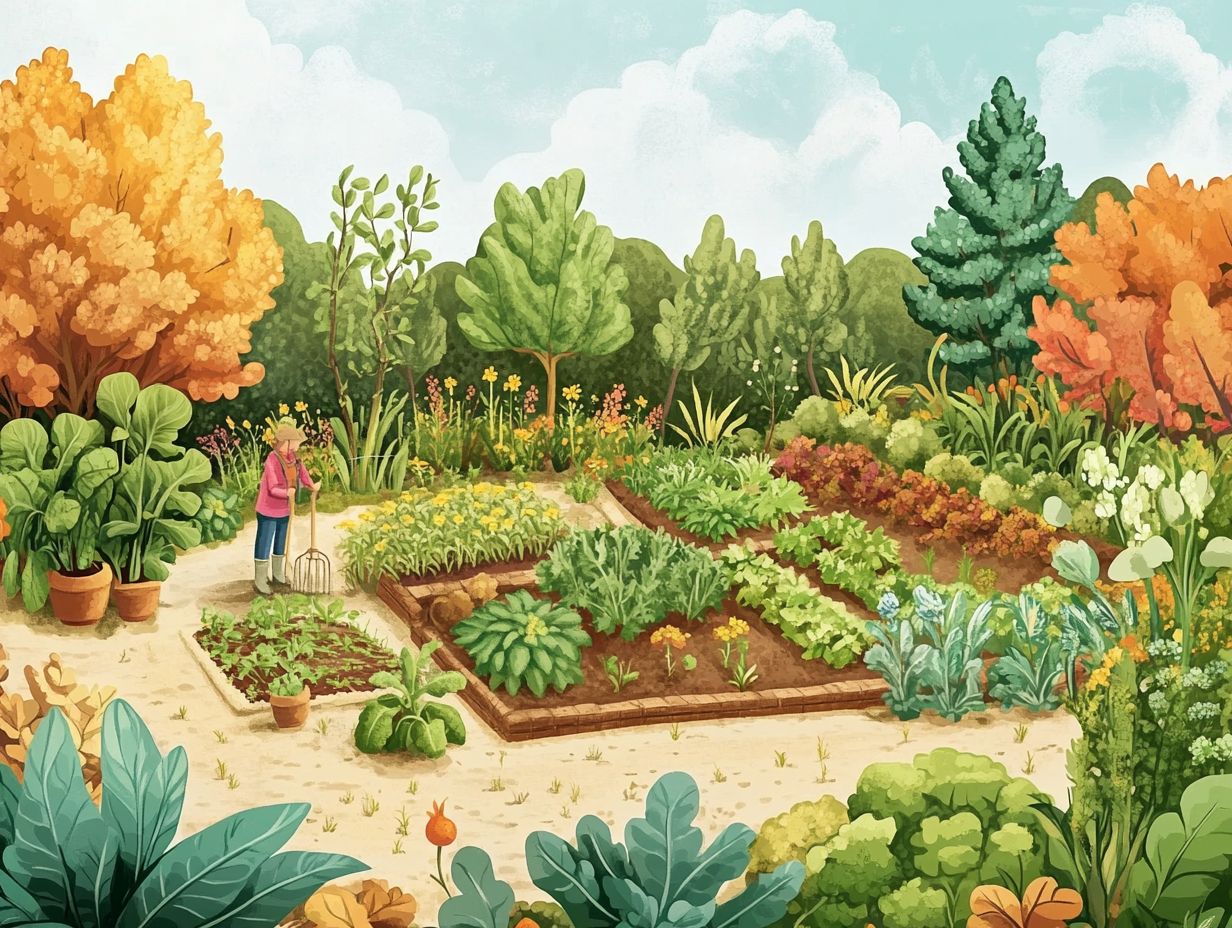
What does permaculture mean?
Permaculture is a sustainable and ecological approach to designing and managing agriculture and living spaces. It aims to mimic the natural patterns and relationships found in ecosystems by integrating ecological design principles.
Start transforming your garden today!
Why Do I Need to Plan for Seasonal Changes in Permaculture?
Seasonal changes greatly impact permaculture systems. Different plants and animals thrive during different seasons, so planning is essential for success.
How Do I Start Planning for Seasonal Changes in Permaculture?
Start by observing the unique seasonal patterns in your area. This observation helps you decide which plants and animals will thrive in each season.
What Are Some Common Methods for Planning Seasonal Changes?
Common methods include creating a seasonal planting calendar and rotating crops. You can also grow different plants together and add seasonal shelters for plants and animals to boost biodiversity.
How Can Permaculture Design Principles Help?
Apply principles like observation, diversity, and integration to plan for seasonal changes. Observing natural patterns reveals which plants will flourish each season.
What Challenges Should I Consider?
Challenges include unpredictable weather, pests, diseases, and limited resources in certain seasons. Have a plan in place and keep observing to adapt to these challenges.



